Best smartwatches for cycling 2022: how to choose the right wearable for your riding
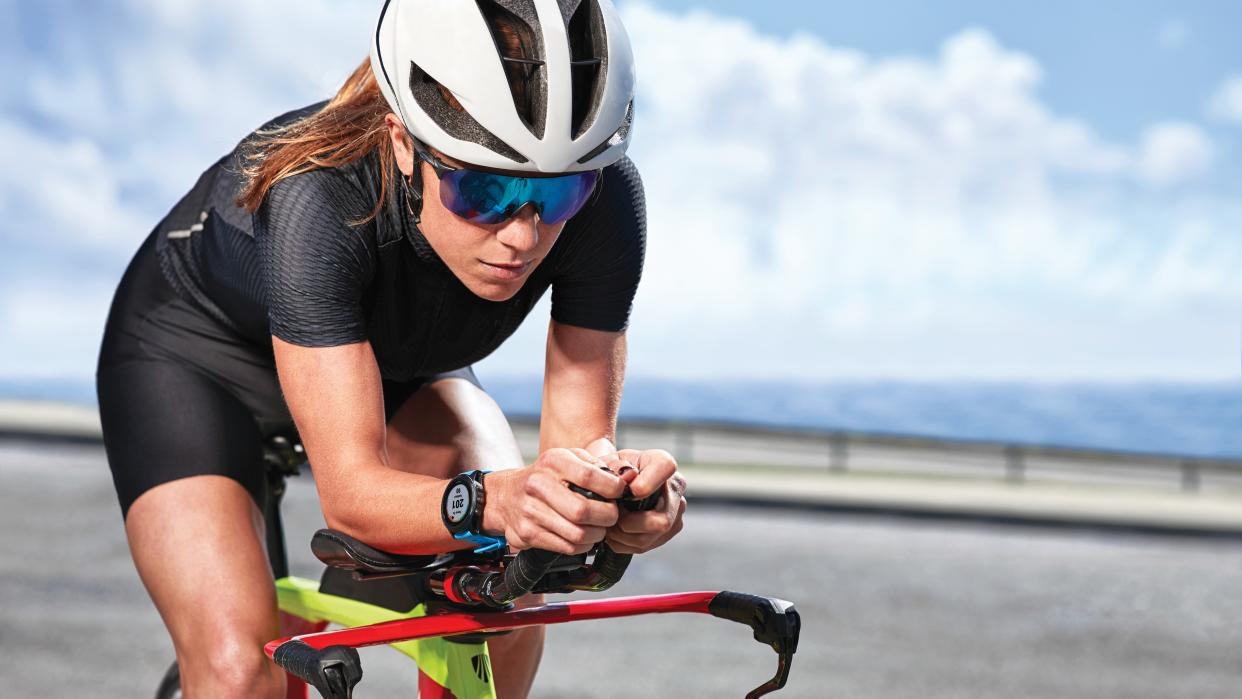
The best smartwatches for cycling are becoming ever more sophisticated. Even the mid-range ones are starting to outperform some of the best cycling computers: not only do they have the same level of functionality and post-ride data analysis but because they’re on your wrist they can be smarter, tracking what’s going on with your body when you’re off the bike as well as on it.
Because they’re on your wrist they’ll track pretty much any sport you do, whether that’s running, swimming, hiking, rowing, skiing or even golfing! You don't need a bike mount (although that's an option with some) and don't need to worry about removing it from your bike when you stop. It's not going to get as mud-splattered as a computer if you go off-road either.
Just like bike computers, GPS smartwatches will pair with peripheral sensors such as power meters and heart rate monitors, and they now almost all have built-in wrist-based optical heart rate monitors. Depending on the model there's navigation too and top spec sports oriented smartwatches will supply all the metrics that a cycling computer does.
Our pick of the best smartwatches for cycling
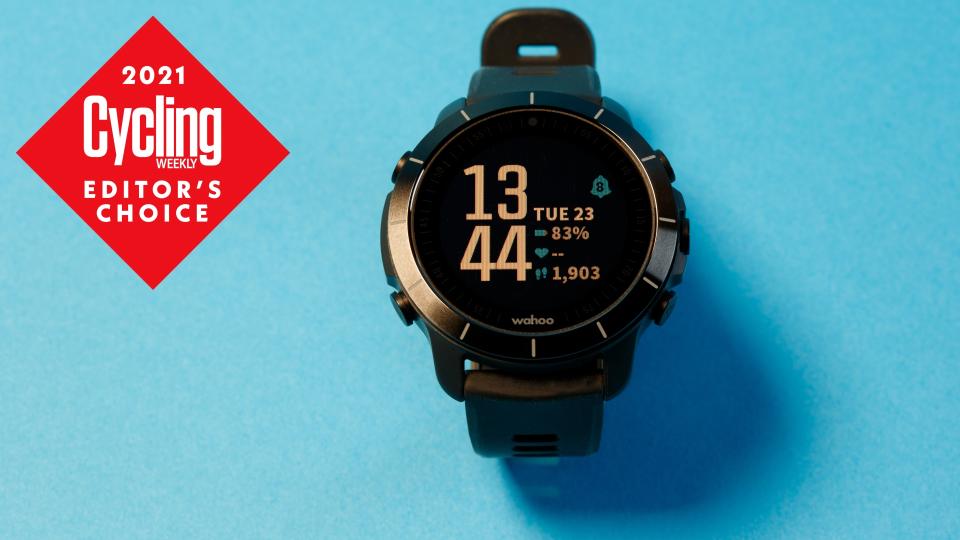
1. Wahoo Elemnt Rival
Best cycling smartwatch for race day
Screen size: 30.4mm | Screen type: Colour | Control: Buttons | Weight: 53g | On board GPS: Yes | On board HRM: Yes | Connectivity: ANT+ / BLE | App: Yes
Simple to use
Reliable pairing and syncing
Accurate wrist-based HRM
Lightweight
Doesn't have fitness tracking functionality (yet)
No touchscreen
The Wahoo Elemnt Rival shares the exact same user-friendly, intuitive functionality as Wahoo’s excellent cycling computers and uses the same app.
Not only that, but compared to other smartwatches it is lightweight and comfortable, the GPS is very accurate, battery life is incredible and the optical heart rate monitor could be the most reliable out there.
Wahoo calls it "radically simplified" – it doesn’t do navigation, sleep tracking or adaptive training guidance so you could say its functionality is limited compared to the more ‘wearable’ orientated watches, but Wahoo intends the Elemnt Rival to be a sports watch for more serious athletes who already know what they’re doing and where they’re going.
If you want a sports-focused watch with the trademark Wahoo clean design, reliable pairing and syncing, an intuitive app and exceptional battery life, the Elemnt Rival is it.
Read our full review of the Wahoo Elemnt Rival.
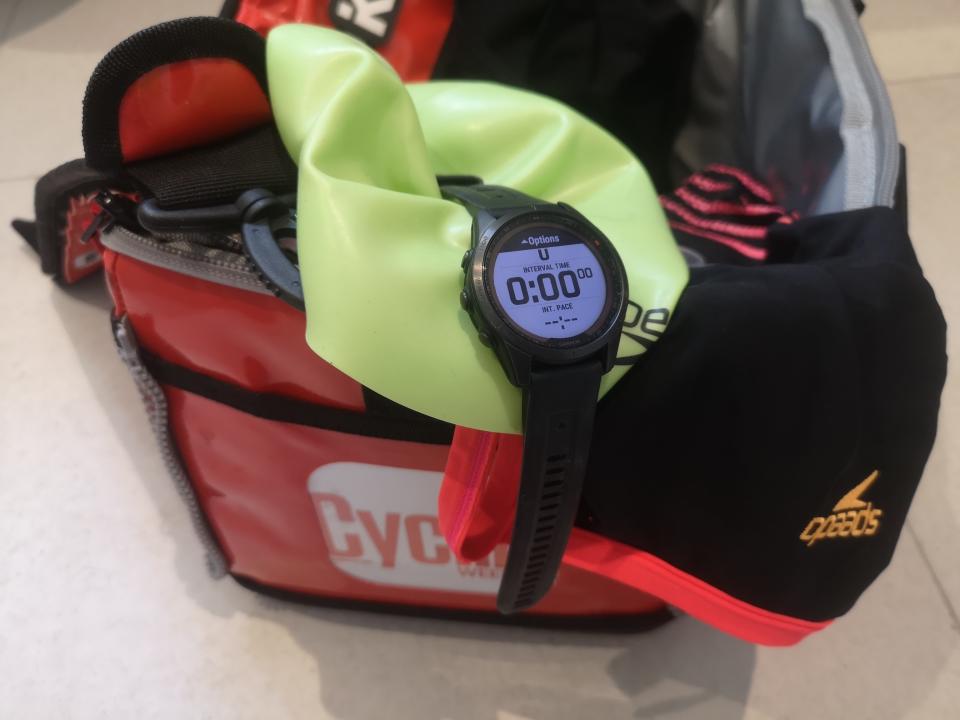
2. Garmin Fenix 7 Sapphire Solar
Best cycling smartwatch for functionality
Screen size: 30.4mm / 33.0mm / 35.6mm | Screen type: Colour touchscreen | Control: Buttons/touchscreen | Weight: 58g - 85g | On board GPS: Yes | On board HRM: Yes | Connectivity: ANT+ / BLE / WiFi | App: Yes
Lots of functionality for sports and fitness tracking
Impressive battery life
Basemaps included
Good computer and mobile app ecosystem
Quite large for smaller wrists
The Garmin Fenix 7 Sapphire Solar packs a lot of functionality into a watch-sized package. That includes not just GPS tracking, but Bluetooth, ANT+ and WiFi connectivity, optical heart rate measurement and pulse oximetry (measuring the oxygen level in your blood). That’s a lot of power hungry functions to keep running – a drain on your battery.
So Garmin has added a solar coating to the glass face of the Fenix 7 which turns the sun’s rays into a boost to the battery, offering up to 5 days of GPS tracking and 5 weeks in smartwatch mode. The Fenix 7 is available without solar charging too and in three different sizes, as well as with a variety of case and strap materials.
It does everything you might want and more, but once you’ve zeroed in on what you want to track it’s easy to use. Functionality includes basemaps, navigation and on-board music and there's a touchscreen interface alongside buttons, making it easy to use.
The Garmin Connect app’s interface is nice and it too can be customised according to your sporting interests.
Read our full review of the Garmin Fenix 7 Sapphire Solar.
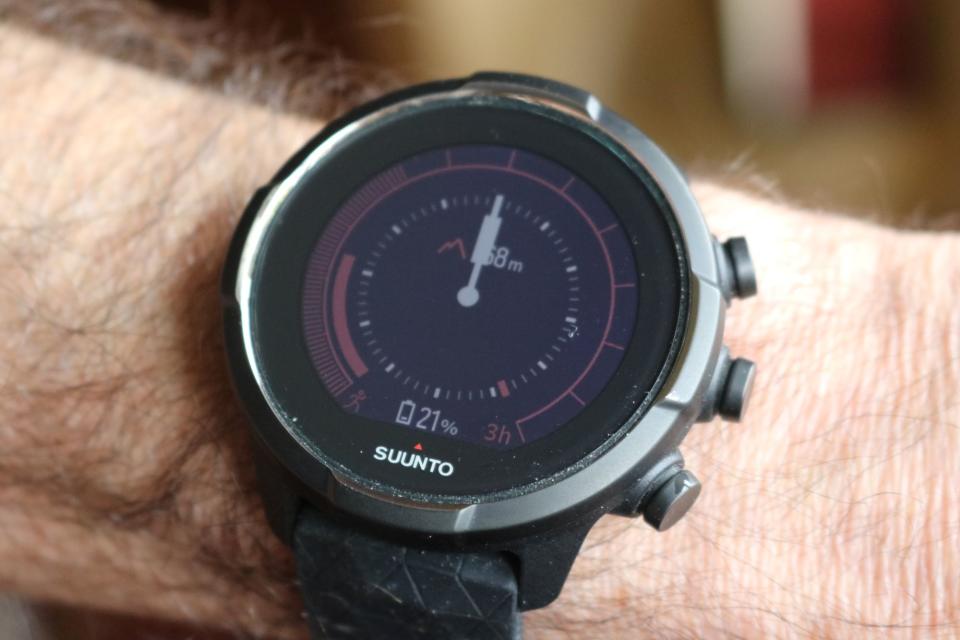
3. Suunto 9 Baro
Best cycling smartwatch for smart battery management
Screen size: 24.0mm (active) | Screen type: Colour | Control: Buttons/ / touchscreen | Weight: 81g | On board GPS: Yes | On board HRM: Yes | Connectivity: BLE | App: Yes
Robust
Good touchscreen
Value against Garmin
Decent battery life
Mapping and navigation not as user friendly as competitors
No basemap when navigating
Less functionality than other smartwatches
The Suunto 9 Baro from the Finnish brand comes with a touchscreen and barometric pressure measurement.
It has a ton of functionality in a package that’s easy to live. It will give you as much data as you want to track your exercise and fitness as well as keeping track of your non-exercise activity during the day. The Suunto 9 Baro works as well for running, swimming, hiking or mountaineering: in fact, there are over 80 sport profiles available.
Suunto has impressive battery management tech. When using the Suunto 9 Baro for a mix of activity tracking, all day wear, and sleep tracking we were always impressed with the battery life. You can expect the better part of a week to pass before thinking about charging.
Read our full review of the Suunto 9 Baro for more.
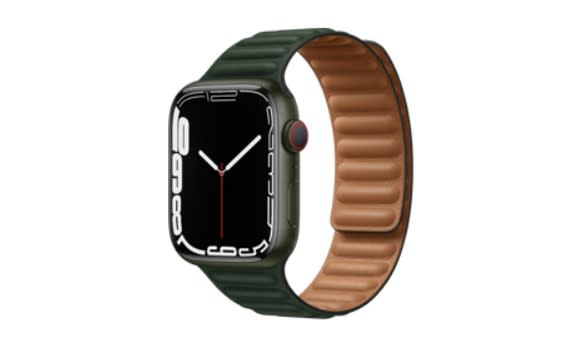
4. Apple Watch Series 7
Best cycling smartwatch for all-round health
Screen size: 41mm / 45mm | Screen type: Colour touchscreen | Control: Buttons / touchscreen | Weight: 32.og / 38.8g | On board GPS: Yes | On board HRM: Yes | Connectivity: BLE | App: Yes
Blood oxygen and ECG monitoring
Strava compatible
Phone and text from your wrist
Touchscreen
Apple Music and Apple Pay
Needs an iPhone
Doesn't connect directly with peripheral sensors
Battery life doesn't match Garmin multisport watches
The Apple Watch Series 7 tracks data from multiple sports and has a built-in altimeter. There's in-built wrist-based heart rate monitoring, but the Series 7's big USP is its blood oxygen monitoring, which is a measure of overall health and fitness. It has a new sensor and app that allows you to take on-demand readings as well as background readings.
There's also an ECG app, which lets you keep an eye on your heart rhythm, indicating early signs of atrial fibrillation (without meaning to scare you).
There's also the fun stuff – access to the 70 million songs on Apple Music, for example.
And the Always-On Retina display, which is 2.5 times brighter when outside, is seriously impressive.
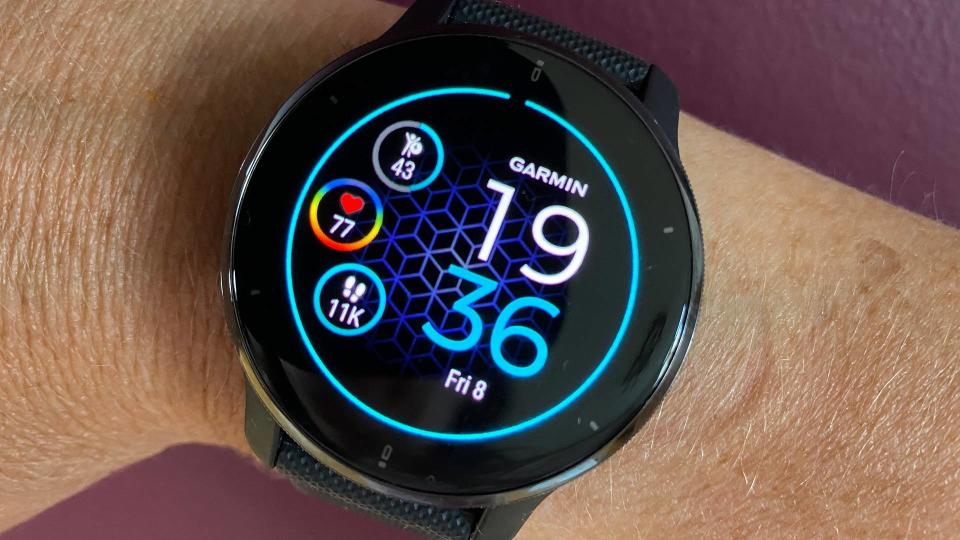
5. Garmin Venu 2 Plus
Best cycling smartwatch for voice commands
Screen size: 33.0mm | Screen type: Colour AMOLED touchscreen | Control: Buttons/touchscreen/voice | Weight: 51g | On board GPS: Yes | On board HRM: Yes | Connectivity: ANT+ / BLE / WiFi | App: Yes
Long battery life
Clear display
Fast recharge
Slow GPS fix
The Garmin Venu 2 Plus boasts a very bright Amoled display which outshines many smartwatches and cycling computers and can be set to be always on or to light up when you move your wrist to see the face. There are loads of different case and strap options.
Control is via three buttons and a touchscreen and the Venu 2 Plus is fast to charge. It has good battery life too when GPS recoding and we got around 7 days between charges. You can also use voice commands, which are actioned via your smartphone app.
There's good functionality to record cycling, as well as other sports, and view metrics as you exercise. You can pair the Venu 2 Plus up with cycling peripherals like a power meter, HRM or the Garmin Varia radar/light.
Read our full review of the Garmin Venu 2 Plus.
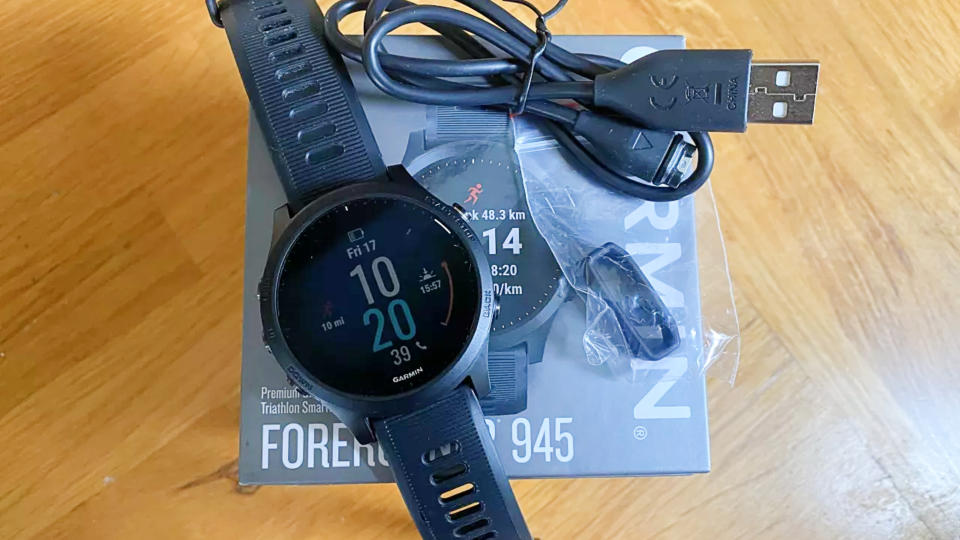
6. Garmin Forerunner 945
Best all-round cycling smartwatch
Screen size: 30.4mm | Screen type: Colour | Control: Buttons | Weight: 50g | On board GPS: Yes | On board HRM: Yes | Connectivity: ANT+ / BLE | App: Yes
Huge functionality for multiple sports
Full colour mapping
Adaptive training plans
Long battery life
Body Battery energy monitor
Music
Garmin Pay
Not as rugged as Fenix 6
No touchscreen
The 945 is the top of the Garmin Forerunner range. It has a huge array of features so that you can track pretty much any sport. As for its cycling-specific functions, is will pair with peripheral sensors via Bluetooth or ANT+, it has sophisticated navigation with turn by turn directions and full colour mapping and you can sync your music from select streaming services. So that you can pay for your post-ride coffee without digging out your wallet or smartphone, it has contactless Garmin Pay.
Sync to Garmin Connect for in-depth tracking of your training, sleep, and general life, and if you want feedback and guidance for future workouts it includes adaptive training plans.
It’s cheaper than the Fenix 7 and the Enduro and is less rugged, but functionality isn’t far behind for a much lower price.
Read our full review of the Garmin Forerunner 945.
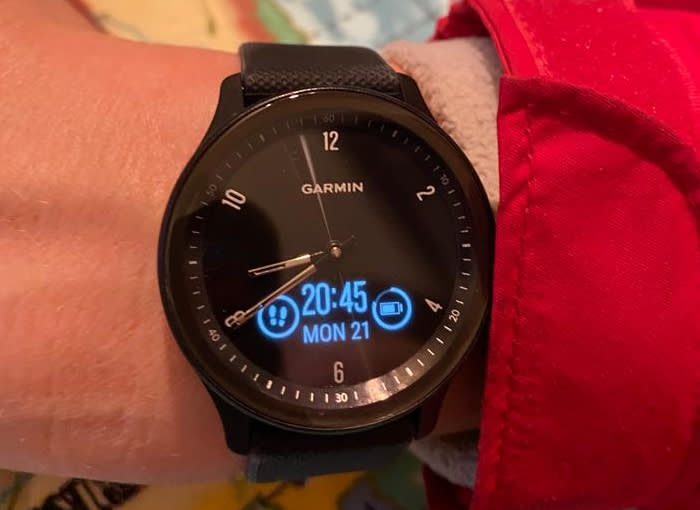
7. Garmin Vivomove Sport
Best cycling smartwatch for stealth functionality
Screen size: 18.5mm | Screen type: Colour | Control: Buttons/touchscreen | Weight: 33.8g | On board GPS: No | On board HRM: Yes | Connectivity: ANT+ / BLE | App: Yes
Lightweight
Stylish
No GPS on board
With a traditional watch face, the Garmin Vivomove Sport has a compact format. The use of real hands means that they can get out of sync with the actual time shown by the digital display when you ride or run off-road, though that's easily rectified.
There's a hidden touchscreen in the lower half of the watch face that opens up an OLED display with more data. You can customise what's displayed via the watch's settings menu.
Battery life is over 5 days, although it's severely impacted if you pair with another device like a phone, which you need to do to get a GPS signal as there's no on-board GPS chip. You can also pair to a Garmin cycling computer to broadcast your heart rate.
Read our full review of the Garmin Vivomove Sport.
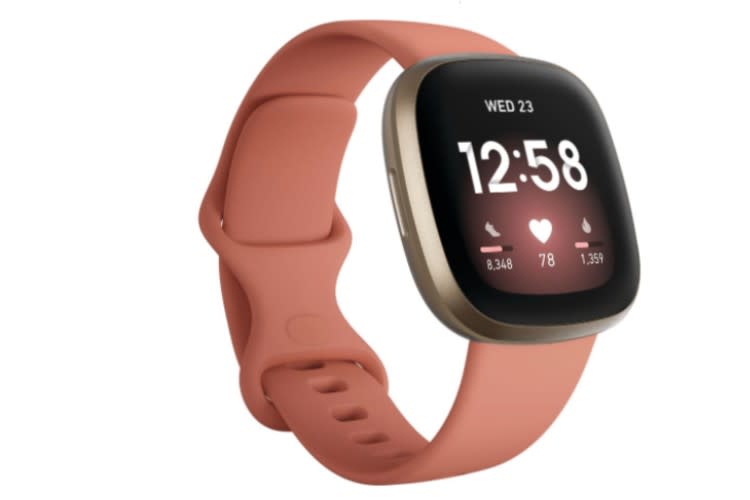
8. Fitbit Versa 3
Best smart features in this price bracket
Screen size: Not specified | Screen type: Colour | Control: Touchscreen | Weight: Not specified | On board GPS: Yes | On board HRM: Yes | Connectivity: BLE | App: Yes
Built in GPS (first time for a Fitbit)
Touchscreen
Google Assistant and Amazon Alexa
Doesn't connect with peripheral sensors
Fitbit and its fitness trackers took the world of daily activity tracking by storm and the brand has continued to make its watches ever more intelligent, as well as making them more appealing to cyclists who want sport-specific functionality.
The Versa 3 has over 20 sport modes, built-in GPS so no need to piggyback onto smartphone GPS as with earlier Fitbits and cardio fitness tracking thanks to its wrist-based heart rate monitor. There's also sleep monitoring and of course step counting and calories burnt.
Fitbit Pay is also included, and music streaming too.
Now that Google owns Fitbit the Versa 3 is Google Assistant and Amazon Alexa enabled, so you can control your smart devices by voice command.
And finally, battery life is impressive and charge time very short.
Buyer's guide to the best smartwatches for cycling
If you're not sure what features are important in a smartwatch for cycling, our buyer's guide will help you to choose the functions that make for a great smartwatch for the cyclist.
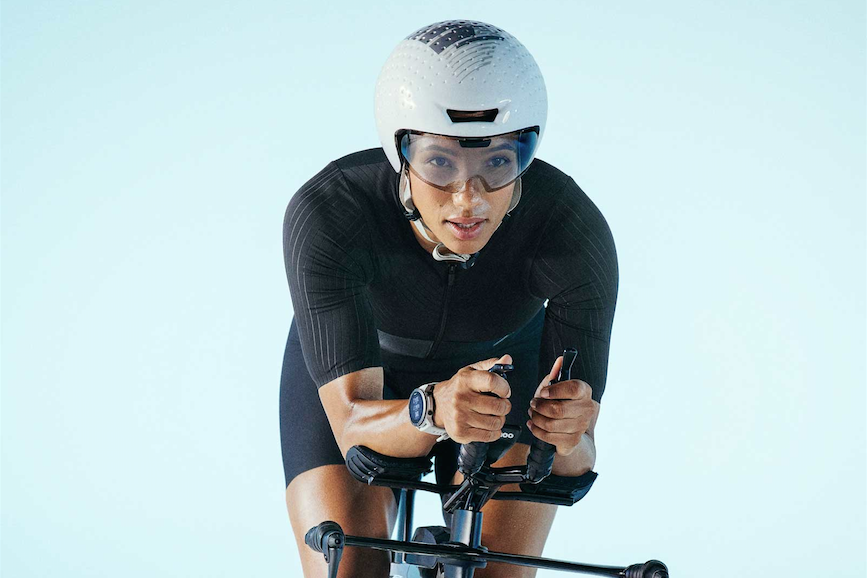
What materials do smartwatches use?
Most sports activity trackers are designed rugged, so that they will withstand knocks and shocks. They're usually waterproof enough for diving too.
More basic models will have a plastic case and strap, but spend more and you'll get a metal bezel or casing, might get a tougher glass face and may be able to purchase a metal strap too.
If your primary goal is sports tracking beware of flashy features though. We've tested high end smartwatches that are heavy and uncomfortable to wear, with sharp metal edges that dig into your wrist when holding the bars.
What features do smartwatches offer for cycling?
GPS tracking will be vital. More basic smartwatches may piggyback from a smartphone for the duration of your rides but now even Fitbit has built-in GPS in many of its fitness trackers.
Many multisport watches also come with barometers and altimeters. This is useful for accurate elevation profiles in recorded data.
Keep in mind though, more sensors mean a greater drain on battery life. They will need a bigger battery, leading to larger watches.
Even if you only use it for cycling, clearly a smartwatch needs to be water resistant. As a starting point we'd recommend an IP67 rating (IP is a rating of the watch's ingress protection – the higher the number, the better the protection).
Do I need a touchscreen?
Some smartwatches have a touchscreen interface, although most work with an array of buttons. Touchscreens can be very intuitive and easy to use off the bike, but when you're riding they can be awkward to operate, so having buttons as well is useful as a fallback.
The decision between touchscreen and buttons is more personal preference than anything else. Buttons can have a more tactile feel and guarantee impressions, whereas the quality of touchscreens, and their performance in wet weather, can vary from brand to brand.
On the other hand, touchscreen displays are often more aesthetically pleasing with less bezel and sometimes with smaller screens. Usually a touchscreen smartwatch will offer buttons too. It may only allow you to use the buttons to control functions during exercise to prevent you from inadvertently stopping recording as you ride.
What battery life can I expect?
The best smartwatches include sophisticated battery management functionality, that lets you eke out plenty of battery life between charges.
You can expect around a week of battery life from the best smartwatches, if you're just using them in smartwatch mode. That will drop significantly once you start to use the GPS chip to track your activities, but even so they should rival the best cycling computers.
If you're going long, a good cycling smartwatch should include the option to dial down battery-intensive functionality to add days to its runtime. That might include lowering the sensitivity or sample rate for GPS tracking or turning off some connectivity functions or in-built sensors, or just powering up less of the screen.
Garmin has added to battery life by including the option to choose solar charging in some of its smartwatches. We didn't find it added much to battery life in the Fenix 6, but battery life has been significantly extended in its replacement Fenix 7. The Garmin Enduro, also solar charged, is claimed to run for up to a year between charges in its lowest power mode and 95 days with low power GPS tracking.
When it does come time to recharge your smartwatch, most use a USB cable, although it might be one with a connector that's specific to your smartwatch.
What navigation features do smartwatches provide?
You can expect route planning and navigation in a smartwatch designed for sports. As a minimum look for a breadcrumb trail of a pre-planned route, but the more sophisticated will include a basemap too.
If you follow a pre-planned route, the best smartwatches will give you turn-by-turn instructions, just like a cycling computer. You may get in-ride rerouting, although you may need to carry your smartphone with you for this.
You may get many of the other features of the best cycling computers like back-to-start routing, hill climb profiles and weather alerts.
What connectivity features should I look for?
Before you buy, check the compatibility of your power meter or cadence sensors with a cycling smartwatch. Some watches don't pair with external sensors, particularly if they're aimed at general fitness as well as cycling.
The best smartwatches for cycling include BLE connectivity to let you link up to these devices. Often you'll get ANT+ connectivity too on devices specifically designed for cycling and multisport tracking.
Optical heart rate sensors work by lighting up your capillaries with an LED. As your blood pumps through, the density changes and the light reflects back differently. The watch then translates this into a beats per minute reading.
Although many smartwatches have wrist-based heart rate monitoring built in, you may get a more accurate measurement if you wear a separate heart rate monitor strap, as movement and sweat at the wrist can affect how well the optical sensor works.
If you already have an HRM, check that the smartwatch will work with it, although most modern HRMs will broadcast both BLE and ANT+ signals.
What health tracking features should I look for in a smartwatch for cycling?
Nearly all smartwatches track the same metrics as basic fitness trackers do. That usually includes step count, calorie burn and sleeping habits. That's usually integrated into an overview of your fitness and often tips and advice on how to improve.
Most of the latest smartwatches for cycling will record heart rate continually while you wear them, giving you a day-to-day record of your resting heart rate. You can use this to see the trend in your fitness level, if you're becoming fatigued, overtrained, ill – and if you're about to hit peak fitness. You may get a prompt from the smartwatch to rest up or do specific drills to help you hit your goals.
Some smartwatches include blood oxygen monitoring. It's useful for tracking adaptation to altitude, but is quite power hungry and only works when you're not moving, so may only operate when you're asleep.
Another function that some smartwatches offer is electrocardiogram traces. You have to initiate these yourself; it's another function that may give you limited useful data.
Most smartwatches will include Bluetooth and/or WiFi connectivity and use this to link to a smartphone app and/or a computer app to upload activities wirelessly. The app will provide more health and exercise analysis and history and you'll get connectivity to Strava and training apps like TrainingPeaks.
What are the drawbacks of using a smartwatch for cycling?
Screen size is obviously limited in a smartwatch compared to the best cycling computers. Some models with larger screens can get a bit chunky, so look out for a size that will feel comfortable to wear, particularly if you're planning to wear your smartwatch day and night for sleep tracking.
Just like with a cycling computer you can usually change what data is displayed on your screen, although you may have to limit how many fields are shown to fewer than with a cycling GPS. The small screen is more limiting with graphic content like routes and maps, where it may be difficult to zoom out or track around enough to see the bigger picture.
On the other hand, you can often set the smartwatch to vibrate to alert you to turns when navigating or to incoming messages from your smartphone.
Attached to your wrist, you may find it's harder to keep an eye on the metrics displayed on a smartwatch than on a cycling computer, which has its screen facing you. Some brands offer bar mounts to let you attach your watch to your bike for better visibility.
What triathlon-specific features do smartwatches provide?
If your exercise targets include triathlons, many smartwatches will include the ability to transition between activities. The Wahoo Elemnt Rival majors on this, with seamless transitions, but other brands like Garmin include this functionality as well.
Both these brands include functionality for mirroring, so that your cycling computer can display data collected during your swim and you get a holistic view of your performance.

